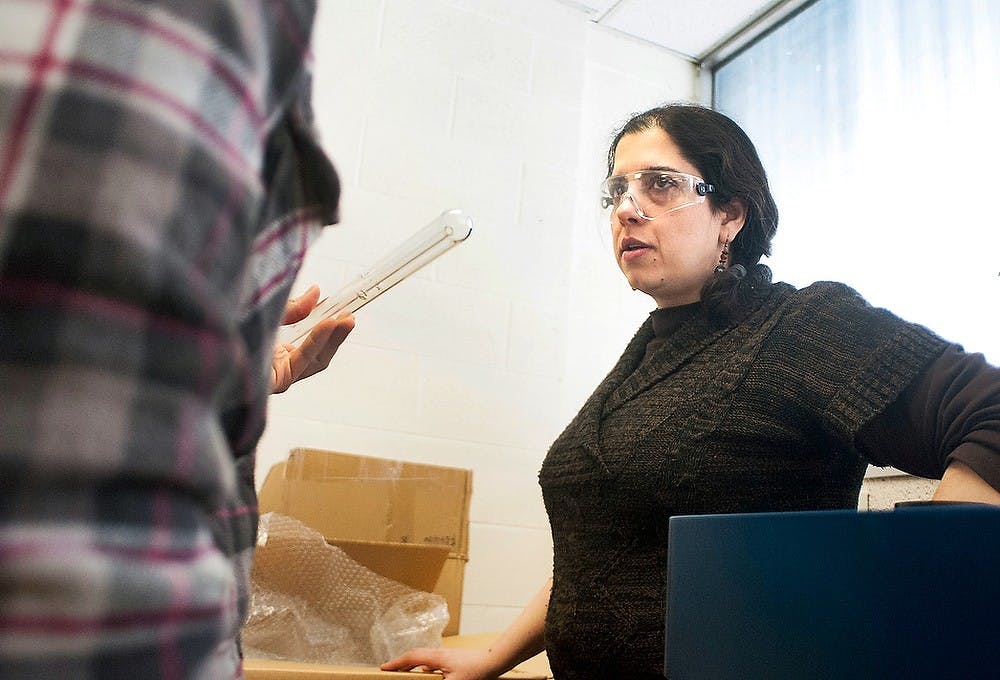Linnea Jimison can pinpoint the moment in high school when she stopped pursuing her interest in science.
“I didn’t see many women, and didn’t get much encouragement (so I) kind of let it go,” said the arts and humanities senior, whose goal is to go into higher education. “In some ways, it’s frustrating to know I’m going into an area that I thought would be fairly gender equal — yet there (are) still so many subtle problems.”
According to MSU data from 2012, the percentage of total female faculty and staff members has increased 5.2 percent since 2002, but the number of female faculty numbers still is lower than their male counterparts.
When examining tenure system faculty, there are 649 fewer women than men employed at MSU.
According to a report from The Chronicle of Higher Education, MSU male professors on average make $129,700 while women make $124,700 in the same position — about a $5,000 gap.
Historically, increasing female presence in the workplace hasn’t necessarily been the easiest task for women. Although females in academia have upped their presence through the past decade, there still is a gender gap in both numbers and pay.
“MSU has been actively pursuing to align that pay gap in terms of gender,” said Jayne Schuiteman, director of the Women’s Resource Center. “I think it’s going to be something that’s going to take a long time, but it’s certainly being addressed.”
Leveling the playing field
At MSU, being taught by a male professor seems to have become the norm.
“The average student is surprised when they see a woman instructor … at the front of the classroom,” Schuiteman said. “They usually expect to see a white male. They probably don’t realize the discrepancy there.”
Schuiteman added this discrepancy is reflective of a national women’s rights issue, saying women have been playing a game of catch up to men in the workforce in regard to both numbers and pay for years.
In an effort to level the scales, Theodore Curry, associate provost and associate vice president for Academic Human Resources, said MSU has turned to grants to try to foster more gender diversity at the departmental level.
Five years ago, MSU received a $4 million grant to increase the number of women employed in the hard sciences, where female faculty numbers are low.
Curry said it’s still too early to see the direct effects of the grant, but he expects the university to follow the upward trend of more women in the workplace and placing more women in positions where they typically haven’t been seen in the past.
“It’s designed to increase the number of women in the disciplines … and to add to the quality and diversity of the faculty at MSU,” Curry said. “Not only in those (science) colleges, but all the colleges … (and) to make broader changes across the entire university.”
Although there are steps being taken to address these disparities, data shows that as females go up the ranks in academia, their presence gets smaller.
About 46 percent of assistant professors at MSU are women. This number dips to 42 percent at the associate professor level and drops to 23 percent for professors.
Ann Marie Ryan, an organizational psychology professor who has done research on gender roles among the faculty at MSU, said some of this can be attributed to the overall difficulties women often experience in the workplace.
She said as women try to climb the ladder of academia, pressures from being in a male-dominated field, time off for maternity leave and raising a family can slow down momentum needed to break the glass ceiling.
“When the women are all very junior and males are all very senior (in rank), it makes that split more defined,” Ryan said. “It makes it a little harder (to move upward), but not impossible … It’s not just that you’re a different gender, but you’re also young, and at a different life stage, and you might be interested in (more family-oriented) activities.”
Maternal instinct
Support student media!
Please consider donating to The State News and help fund the future of journalism.
Since traveling to different universities throughout the country, Melanie Cooper, a professor in the Department of Chemistry, said the atmosphere is different when the genders in the department are closer to 50/50.
Cooper visits numerous universities, some of which have more equal gender representation than MSU’s Department of Chemistry.
“There’s a difference in the way people interact,” Cooper said. “I really don’t know how to put it in words.”
Ryan said depending on the faculty member, there can be a gender-based difference in their demeanor.
She considers the difference to be a phenomenon in higher education called “Academic Mom-ism” — an idea that female professors are expected to be more nurturing and sensitive toward students.
Because of this, women are often encouraged to go into administrative positions, which can derail them from focusing on personal research and academic development, Ryan said.
As an elementary education senior, David Thomas said he doesn’t expect his female professors to be more sensitive, but he has encountered this in the female professors he has had in his four years at MSU.
“That’s just the social norm,” Thomas said. “That’s why a lot of times, to relate to elementary education, you see so many females … (Because of these) expectations that women are more nurturing than men.”
Cooper didn’t say if her teaching methods were influenced by her maternal instincts, but she attributed her consciousness to being sensitive with her students to humanity itself.
“I try to show (students) that I’m a human being,” Cooper said.
Discussion
Share and discuss “Women in Waiting” on social media.







